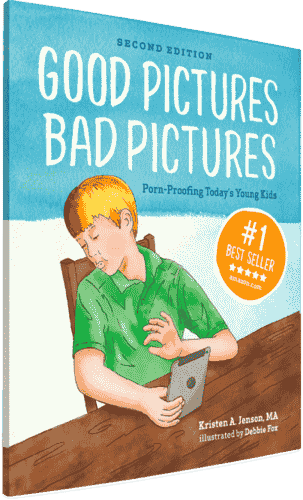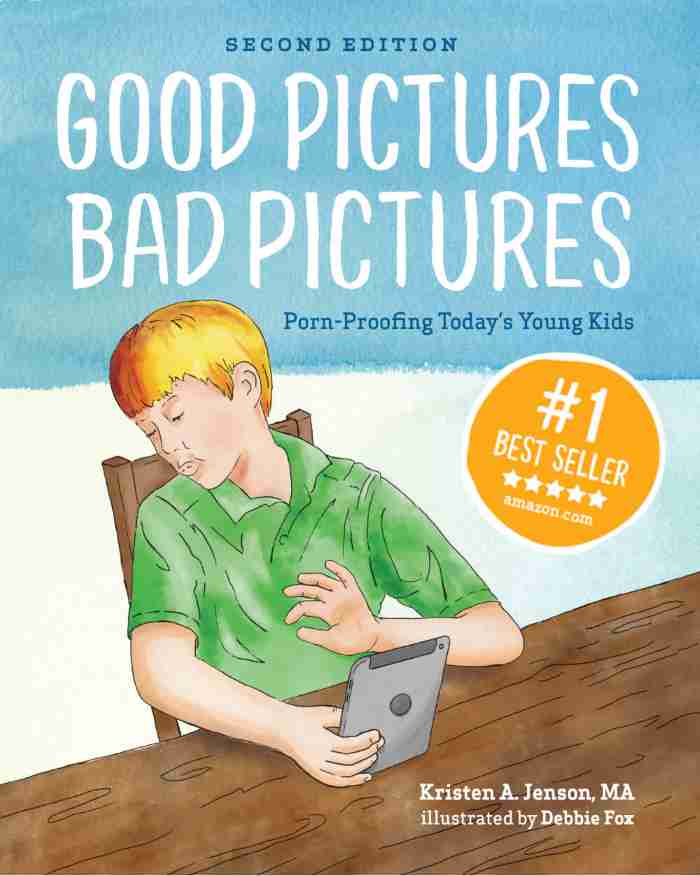

Art vs Porn: How to Explain the Difference to a Child
Is it art or is it porn? Teaching kids a definition of pornography can be tricky when it comes to fine art. Even the Sistine Chapel ceiling includes nude figures of Adam and Eve and a whole host of chubby naked cherubs!
Your kids may say, “That’s pornography!” but you know it’s really not. How do you explain the difference between an age-appropriate definition of pornography and the nudity that is sometimes a part of fine art?

Defining pornography as pictures of people with little or no clothes on is age-appropriate for a young child. However, a child will outgrow this simple definition. When kids visit an art museum and see a nude picture or statue that is not generally considered pornography, they'll need a more complete explanation.
That’s why we include a conversation of how pornography makes kids feel in the best-selling read-aloud book, Good Pictures Bad Pictures.
One of the rare negative Amazon reviews we’ve received on Good Pictures Bad Pictures is titled “WARNING: Do not take your child to an art museum after reading this book.” The reviewer states, “...if you have any intention of visiting Europe, or an art museum, or owning a book about art, or National geographic magazines/videos, or watching many movies, you may need to have a more nuanced discussion with your child first.”
OK! Challenge accepted! How do you explain the difference between “art” and “porn” to a child when they both include nudity?
Porn is the opposite of art
First, it's important to understand that porn is the opposite of true art.
True art, whether it's visual, auditory or written, invites a person to think, to ponder, to wonder or to consider something new, a different perspective perhaps. Art doesn’t necessarily have to be beautiful, but it should say something of worth. Something to enlighten us. Great artists are also great thinkers.
I asked a friend who is a mom for her thoughts on porn vs. art, and here's what she had to say!
Ultimately, there are two things to consider when judging whether something is art or pornography: the way the art makes an individual feel and the intention of the artist. The first may be easier for a child to figure out than the second.
While art is intended to create awe for the human body as a whole, pornography is created with the hope that the viewer’s attention will focus only on body parts (the parts normally covered by a swimsuit.) Art may have many purposes. Pornography only has one: to create or intensify sexual feelings.
But children are not developmentally prepared for such feelings. They might describe porn's effect on them as a strong desire to see more. Children might experience a disorienting, intense fascination they can't get out of their mind. It's important for parents to talk to children about their feelings and listen. An image that isn't pornography for parents may still be pornography for a child.
[[CTA]]
Porn often masquerades as art
A few years ago, the Seattle Art Museum (SAM) sponsored the Elles: Pompidou “Women Take Over” exhibit. One of the most shocking examples of “art” was a video of a naked woman ripping her bloodied waist apart with a barbed wire hula hoop. Another was a video tube of sorts that you went inside--it was designed to give visitors the experience of being inside a vagina during sexual climax. WHAAATT???
Let me see by a show of hands how many want their kids at this art exhibit!
But what did the critics have to say? Seattle Magazine pronounced,
“The work is shocking, funny, disturbing, sexual, pissed off, poignant and exuberant (as all good art tends to be).”
I beg to differ. This is not good art. It's the opposite of art! Any media that attempts to shock, titillate, create sensation for sensation’s sake, and portray gratuitous horror is not good art. Porn is the opposite of art because it portrays sexual scenes that tap into one’s libido instead of one’s heart and mind.
Pornography may be memorable, even for a lifetime. But it’s meant to shock, titillate and addict, rather to enlighten us about what it means to be a thinking, ethical, empathetic human being.
Check out this eye-opening video featuring an art professor commenting on why modern art often includes the pornographic.
So how do you explain porn vs. art to a child?
Here are four suggestions that will help you begin the conversation. Depending on your child’s age, it may not be easy for them to understand the nuanced differences, but it’s definitely worth beginning this discussion:
- Define pornography as not only what it is but how it makes you feel. Does it cause a physical excitement? Does it make you want to look at other nude pictures?
- Teach kids that porn focuses on parts of the body, but good, true art focuses on the entire person as a unique human being. Does this picture cause you to focus on the private parts more than the entire body? Is there a reason the person is portrayed without clothes on? (For example, it’s reasonable that a painting of Adam and Eve in the Garden of Eden would show them without clothes on the ceiling of the Sistine Chapel.)
- Art exalts the human form and portrays it with awe and respect. Porn degrades the human body--again, using artificially enhanced bodies to arouse sexual feelings that may cause you want to act out on those feelings.
- Good, true art makes us want to do something positive--for example, right a wrong, reflect on our own mistakes, or appreciate beauty. Pornography, on the other hand, wants to create or intensify sexual feelings and pull us into a self-centered and ultimately destructive lust.
As kids mature, so can their understanding of the definition of pornography. After children have a basic understanding of sex, parents can initiate more nuanced discussions about what constitutes pornography.
When kids are younger, parents can help them understand that art is much more complex (and interesting) than pornography. Pornography at its core has only one function: to create intense sexual feelings that drive a person to want to see more. Pornography improves nothing and enlightens no one. It neither brings awareness to problems nor solves them.
As Fight the New Drug so clearly reveals, pornography is harmful to individuals, to relationships and society.
The more kids understand what pornography is and how it’s impacting their world, the stronger their internal filter -- their personal desire to reject pornography -- will become.



Good Pictures Bad Pictures
"I really like the no-shame approach the author takes. It's so much more than just 'don't watch or look at porn.' It gave my children a real understanding about the brain and its natural response to pornography, how it can affect you if you look at it, and how to be prepared when you do come across it (since, let's face it... it's gonna happen at some point)." -Amazon Review by D.O.








